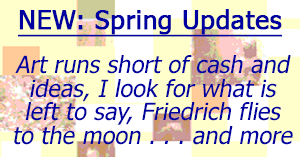A Little Teapot
Had he wished, Martin Puryear could have become a household icon. Thanks to the Morgan Library, through January 10, his work may yet become one.
A show of works on paper and sculpture recovers his design sense, while again insisting that the museum has a stake in modern and contemporary art, too. It also insists on the artist’s roots in expressive and figurative art, even in work that could stand for an ordinary household product.  It notes his personal history in black culture, but it does not necessarily unfold in black America—and I have added this to report on his 2007 MoMA retrospective as a longer review and my latest upload.
It notes his personal history in black culture, but it does not necessarily unfold in black America—and I have added this to report on his 2007 MoMA retrospective as a longer review and my latest upload.
Many more people know Michael Graves from his tea kettle than from his buildings. In its simplicity and utter refusal of quaintness, it has none of the slick Postmodernism of Graves in architecture. (I confess, I own a knockoff myself.) And the focus of Puryear’s “Multiple Dimensions,” at the is missing only its spout. You may be tempted to start pouring anyway.
It is, first and last, abstract sculpture, but its plainness thrives on ambiguity. Its bulging outline could pass for the haunch of an animal, with the small round loop at right its head. Then again, it could represent a human head, its face buried in earth or sand. Another version in the small lobby gallery transforms it into a monument, dwarfing the model person beside it. Excuse me, though, if I still want to see it in stores, with that loop its handle. It would bring the energy of mass culture to a fine sculptor’s courtly silence.
Not for Puryear the stark geometry of Tony Smith or the dangerous welding of Melvin Edwards. Not for him the industrial materials of Minimalism and its way of refusing to get up off the floor. Between his reticence, his hints of expressionism and human form, and his belief in traditional media, he could belong to another country or another time. Yet he had a studio in Brooklyn until a fire in 1977 destroyed its contents and drove him to Chicago. He later moved to upstate New York. Another sculpture, two tree limbs descending from a small open cube high on the wall, places him squarely with the raw physical sensation of American Post-Minimalism.
 Drawings and prints upstairs, curated by the Art Institute of Chicago, seek to restore the human context to all his work, eight years after his retrospective singled out his African American abstraction. The show’s title aside, with its reference to sculpture, they display him as working along a single dimension. Born in 1941, he joined the Peace Corps in 1964, stationed in Sierra Leone. While he sketches camels there and a shelter, he prefers people, faces, and silent suffering. The show soon leaps ahead to just the last fifteen years, with an abundance of human heads, darkly shadowed but close to abstraction. Even in Conté crayon, a demanding medium that rewards precision, the accumulated lines smear out into blackness.
Drawings and prints upstairs, curated by the Art Institute of Chicago, seek to restore the human context to all his work, eight years after his retrospective singled out his African American abstraction. The show’s title aside, with its reference to sculpture, they display him as working along a single dimension. Born in 1941, he joined the Peace Corps in 1964, stationed in Sierra Leone. While he sketches camels there and a shelter, he prefers people, faces, and silent suffering. The show soon leaps ahead to just the last fifteen years, with an abundance of human heads, darkly shadowed but close to abstraction. Even in Conté crayon, a demanding medium that rewards precision, the accumulated lines smear out into blackness.
As its centerpiece, the upstairs gallery also has the show’s largest sculpture. Thick blond timbers take the shape of a bottle turned on its side, as if about to pour. And works not in the show do indeed have a spout, like the one pictured here. Within the vessel, though, additional sculpture has the shape of an ampersand and a period—their accumulated mass in fruitful contrast with the open lattice. Are they enclosed by the sculpture or looking beyond it? Either way, they signal more than meets the eye.
Read more, now in a feature-length article on this site.
SOURCE: Haberarts - Read entire story here.
Read More